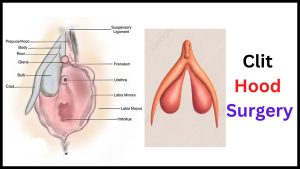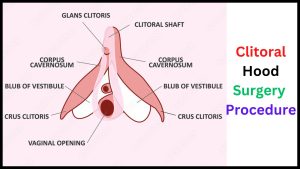
Are you curious about clit hood surgery?
If so, you’re in the right place!
This article will provide you with essential information about this procedure.
Clit hood surgery, also known as clitoral hood reduction or clitoral unhooding, is a surgical procedure that involves removing excess tissue from the clitoral hood.
This surgery is often performed to alleviate discomfort or enhance sexual satisfaction.
Stay tuned to learn more about the reasons to consider this surgery, the procedure itself, and the potential risks and benefits involved.
Clit Hood Surgery: What to Know About Clitoral Hood Surgery
What is Clitoral Hood Surgery
Definition
Clit hood surgery (Clitoral Hood Surgery), also known as clitoroplasty or hood ectomy, is a surgical procedure that aims to alter the size, shape, or appearance of the clitoral hood.
The clitoral hood is the fold of skin that covers and protects the clitoris, which is a highly sensitive organ located at the top of the vulva.
This procedure is often performed for both aesthetic and functional reasons, such as improving sexual satisfaction or addressing discomfort associated with an enlarged or asymmetrical clitoral hood.
Reasons for Clitoral Hood Surgery (Clit Hood Surgery)
There can be several reasons why an individual may consider clitoral hood surgery.
One common reason is an enlarged or elongated clitoral hood, which can make it difficult to stimulate the clitoris during sexual activities.
By reducing the size of the clitoral hood, the clitoris is more exposed, potentially enhancing sexual pleasure.
Additionally, some individuals may experience discomfort or irritation due to excessive rubbing or friction caused by an abnormally long or thick clitoral hood.
In such cases, clitoral hood surgery can alleviate these symptoms and improve overall comfort.
Types of Clitoral Hood Surgery
Clitoral Hood Reduction
Clitoral hood reduction involves removing excess tissue from the clitoral hood to decrease its size and improve its function.
This procedure is typically performed when the clitoral hood is disproportionately large or elongated, hindering sexual stimulation.
During the surgery, the surgeon carefully trims and reshapes the excess tissue, resulting in a more proportionate and aesthetically pleasing appearance.
Clitoral Hood Reconstruction
Clitoral hood reconstruction is a procedure aimed at restoring or enhancing the appearance and function of the clitoral hood.
This type of surgery is often pursued by individuals who have experienced trauma, or injury or have undergone female genital mutilation (FGM).
By reconstructing the clitoral hood, surgeons can improve the aesthetic appearance and help restore normal sexual function, sensitivity, and self-confidence.

Clitoral Hood Surgery Procedure
Preparation
Before undergoing clitoral hood surgery(Clit Hood Surgery), it is crucial to consult with a qualified and experienced surgeon who specializes in female genital plastic surgeries.
During the consultation, the surgeon will evaluate your overall health and discuss your desired outcomes.
They will explain the procedure in detail, address any concerns or questions you may have, and provide pre-operative instructions to follow, such as refraining from smoking or certain medications.
Anesthesia
Clitoral hood surgery( Clit Hood Surgery)can be performed under local anesthesia with sedation or general anesthesia, depending on the complexity of the procedure and patient preference.
Your surgeon will determine the most suitable type of anesthesia after considering various factors, such as your medical history, procedure extent, and personal comfort.
Incision and Removal of Excess Tissue
Once the anesthesia takes effect, the surgeon will begin the procedure by making precise incisions in the clitoral hood.
The excess tissue or skin is carefully removed, taking utmost care to preserve the nerve endings and blood supply that contribute to clitoral sensation.
The surgeon will skillfully sculpt the remaining tissue to achieve the desired size and shape of the clitoral hood.
Closure
After the necessary modifications have been made, the incisions are meticulously closed using dissolvable sutures.
The surgeon may also apply surgical adhesive or steri-strips to further support the incision site.
This promotes proper healing and minimizes the risk of postoperative complications.
Recovery
Following clitoral hood surgery, it is important to rest and allow your body to heal.
Your surgeon will provide detailed post-operative instructions, which typically include gentle cleansing of the surgical area, avoiding strenuous activities and sexual intercourse for a few weeks, and wearing loose, comfortable clothing to minimize irritation.
While discomfort and swelling are common during the initial stages of recovery, they can be managed with pain medication prescribed by your surgeon.

Choosing a Surgeon
Board Certification
When selecting a surgeon for clitoral hood surgery, it is crucial to ensure they are board-certified in plastic surgery or gynecology.
Board certification reflects a surgeon’s competence and expertise in specialized procedures like clitoral hood surgery.
This certification demonstrates that the surgeon has undergone extensive training, met rigorous standards, and has a commitment to ethical practices.
Experience
In addition to board certification, the surgeon’s experience is an important factor to consider.
It is advisable to choose a surgeon who has performed numerous clitoral hood surgeries and has a track record of successful outcomes.
You can inquire about their experience during the consultation or ask for before-and-after photos of previous patients to evaluate their surgical skills.
Reviews and Testimonials
Reading reviews and testimonials from previous patients is an excellent way to gauge the surgeon’s reputation and patient satisfaction.
Websites, social media platforms, and independent review sites can provide valuable insights into the surgeon’s bedside manner, professionalism, and overall patient experience.
Positive reviews and testimonials can give you confidence and reassurance in your choice of surgeon.
Consultation
A thorough and informative consultation is necessary to establish a rapport with your surgeon and ensure that your goals and expectations are understood.
Take this opportunity to ask any questions you may have regarding the procedure, recovery, and potential risks.
A reputable surgeon will address your concerns and provide honest and realistic expectations, allowing you to make an informed decision.

Risks and Complications
Infection
As with any surgical procedure, there is a risk of developing an infection following clitoral hood surgery.
To mitigate this risk, it is essential to adhere to the post-operative care instructions provided by your surgeon.
This may involve keeping the surgical area clean, taking prescribed antibiotics, and avoiding exposure to potential sources of infection.
Bleeding
Although uncommon, some patients may experience post-operative bleeding.
It is normal to have minimal spotting or oozing immediately after the surgery, but excessive or persistent bleeding should be reported to your surgeon promptly.
To minimize the risk of bleeding, avoid vigorous physical activities or straining during bowel movements during the early stages of recovery.
Scarring
Scarring is an expected outcome of clitoral hood surgery, but its visibility and extent vary from person to person.
Experienced surgeons make incisions in inconspicuous locations and use precise closure techniques to minimize the appearance of scars.
It is important to follow the surgeon’s scar management instructions, such as applying topical treatments or avoiding excessive sun exposure, to promote optimal healing and reduce the visibility of scars.
Nerve Damage
The clitoral hood contains delicate nerve endings responsible for sexual pleasure and sensation.
While every effort is made to preserve these nerves during surgery, there is a small risk of temporary or permanent nerve damage.
This could potentially result in altered sensation or decreased sexual satisfaction.
However, with a skilled and experienced surgeon, the risk of significant nerve damage is minimized.

Recovery and Aftercare
Post-operative Instructions
Following clitoral hood surgery, your surgeon will provide detailed post-operative instructions tailored to your specific case.
These instructions typically include information on wound care, bathing, and hygiene practices.
It is important to follow these instructions diligently to minimize the risk of infection and promote proper healing.
Pain Management
Mild to moderate discomfort is common after clitoral hood surgery.
Your surgeon will prescribe pain medication to manage any pain or discomfort.
It is important to take the medication as directed and communicate any persistent or severe pain to your surgical team.
Additionally, applying cold packs to the surgical area can help reduce swelling and alleviate discomfort during the initial recovery period.
Follow-up Appointments
Attending follow-up appointments with your surgeon is crucial to monitor your healing progress and ensure optimal outcomes.
These appointments allow your surgeon to assess the healing of the surgical site, remove any sutures if necessary, and address any concerns or questions you may have.
Regular follow-up appointments also provide an opportunity to discuss any adjustments or modifications that may be required.
Physical Activities
During the recovery period, it is important to avoid vigorous physical activities, heavy lifting, and sexual intercourse for a few weeks.
These activities can put unnecessary strain on the surgical area and potentially hinder the healing process.
Your surgeon will provide specific guidelines regarding the resumption of physical activities, ensuring that your body has adequate time to heal and recover.

Results and Expectations
Healing Process
The healing process after clitoral hood surgery can vary from person to person.
Initially, there may be swelling, bruising, and mild discomfort, which are expected and temporary.
As the weeks progress, these symptoms typically subside, and the final results begin to emerge.
It is important to have reasonable expectations and understand that the full healing process may take several months.
It is best to consult with your surgeon to understand the anticipated timeline for recovery in your specific case.
Change in Sensation
Clitoral hood surgery can potentially result in a change in sensation around the clitoral area.
While some individuals may experience heightened sensitivity, others may notice a decrease.
Individual responses vary, and the extent of sensation change will depend on various factors, including the surgical technique used and the unique anatomy of the patient.
It is important to have open and honest discussions with your surgeon about your expectations regarding sensation changes.
Enhanced Sexual Satisfaction
For individuals who undergo clitoral hood surgery to improve sexual satisfaction or alleviate discomfort, the procedure can yield positive outcomes.
By reducing the size or altering the shape of the clitoral hood, the clitoris becomes more easily accessible during sexual activities, potentially enhancing pleasure and orgasmic experiences.
While results can vary, many patients report improved sexual satisfaction and increased self-confidence after clitoral hood surgery.

Cost of Clitoral Hood Surgery
Factors Affecting Cost
The cost of clitoral hood surgery can vary depending on various factors.
These factors may include the geographical location of the surgeon’s practice, the complexity of the procedure, the surgeon’s experience and reputation, and the facility fees.
It is important to consult with your surgeon to obtain a comprehensive understanding of the potential costs involved, including anesthesia fees, surgical facility fees, and any post-operative care expenses.
Insurance Coverage
In most cases, clitoral hood surgery is considered an elective cosmetic procedure and is not covered by insurance.
However, there may be exceptions if the surgery is deemed medically necessary, such as in cases where the clitoral hood causes significant physical discomfort.
It is advisable to contact your insurance provider to determine if any coverage is available or to explore potential financing options.
Alternative Options
Non-surgical Treatments
For individuals seeking alternatives to clitoral hood surgery(clit hood surgery), there are non-surgical treatments available.
These options may include hormone therapy, topical creams, or devices designed to enhance clitoral sensitivity or promote tissue tightening.
It is essential to consult with a qualified healthcare professional to discuss the suitability of these treatments based on your individual needs and goals.
Alternative Procedures
In some cases, individuals may explore alternative procedures that address concerns related to the clitoral hood indirectly.
These procedures may include labiaplasty, vaginal rejuvenation, or other genital cosmetic surgeries.
It is important to consult with a knowledgeable and experienced surgeon to determine the most appropriate procedure based on your specific concerns and desired outcomes.
Clitoral Hood Surgery and Female Genital Mutilation
Differences and Misconceptions
Clitoral hood surgery should not be confused with female genital mutilation (FGM).
FGM, also known as female circumcision, is a cultural practice that involves the removal or alteration of various parts of the female genitalia for non-medical reasons.
Clitoral hood surgery, on the other hand, is a voluntary procedure performed with the informed consent of the individual and aims to address personal concerns or improve sexual satisfaction.
Ethical Considerations
As clitoral hood surgery is a personal choice, it is important to approach the procedure with careful consideration and understanding.
Surgeons who perform clitoral hood surgery should prioritize the well-being and autonomy of their patients while adhering to medical and ethical standards.
It is crucial for healthcare professionals to provide comprehensive information, educate patients about potential risks and benefits, and ensure that the decision to undergo clitoral hood surgery is completely voluntary and informed.
